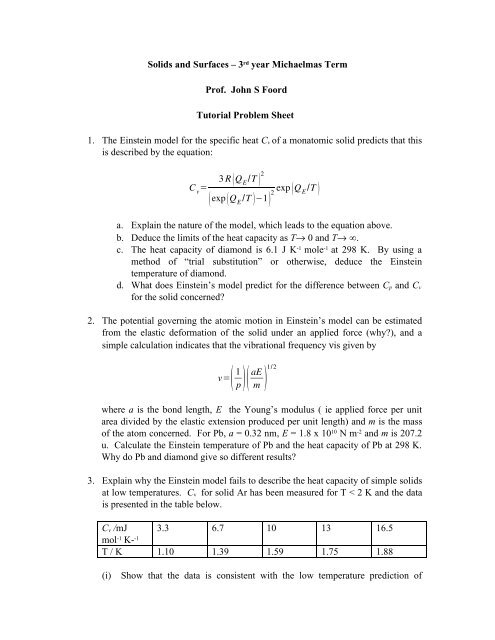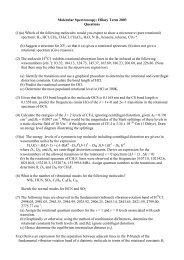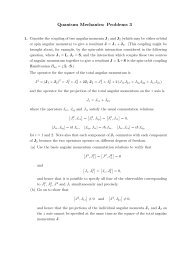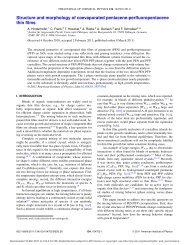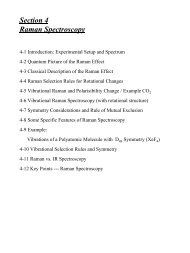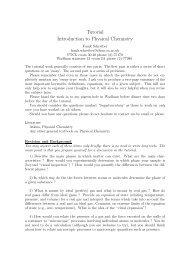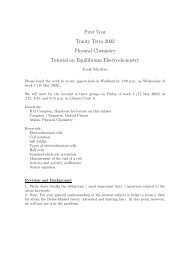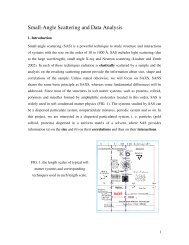Solids and Surfaces – 3rd year Michaelmas Term
Solids and Surfaces – 3rd year Michaelmas Term
Solids and Surfaces – 3rd year Michaelmas Term
You also want an ePaper? Increase the reach of your titles
YUMPU automatically turns print PDFs into web optimized ePapers that Google loves.
<strong>Solids</strong> <strong>and</strong> <strong>Surfaces</strong> – 3 rd <strong>year</strong> <strong>Michaelmas</strong> <strong>Term</strong>Prof. John S FoordTutorial Problem Sheet1. The Einstein model for the specific heat C v of a monatomic solid predicts that thisis described by the equation:C v= 3 R Q E/T 2 exp Q E/T −1 2 exp Q E/T a. Explain the nature of the model, which leads to the equation above.b. Deduce the limits of the heat capacity as T→ 0 <strong>and</strong> T→ ∞.c. The heat capacity of diamond is 6.1 J K -1 mole -1 at 298 K. By using amethod of “trial substitution” or otherwise, deduce the Einsteintemperature of diamond.d. What does Einstein’s model predict for the difference between C p <strong>and</strong> C vfor the solid concerned?2. The potential governing the atomic motion in Einstein’s model can be estimatedfrom the elastic deformation of the solid under an applied force (why?), <strong>and</strong> asimple calculation indicates that the vibrational frequency νis given byv= 1 p aE 1/2m where a is the bond length, E the Young’s modulus ( ie applied force per unitarea divided by the elastic extension produced per unit length) <strong>and</strong> m is the massof the atom concerned. For Pb, a = 0.32 nm, E = 1.8 x 10 10 N m -2 <strong>and</strong> m is 207.2u. Calculate the Einstein temperature of Pb <strong>and</strong> the heat capacity of Pb at 298 K.Why do Pb <strong>and</strong> diamond give so different results?3. Explain why the Einstein model fails to describe the heat capacity of simple solidsat low temperatures. C v for solid Ar has been measured for T < 2 K <strong>and</strong> the datais presented in the table below.C v /mJ 3.3 6.7 10 13 16.5mol -1 K- -1T / K 1.10 1.39 1.59 1.75 1.88(i) Show that the data is consistent with the low temperature prediction of
Debye’s theory, <strong>and</strong> calculate the Debye temperature.(ii) Calculate the entropy of solid Ar at 5 K.(iii) Potassium has the same Debye temperature as Ar, but the heat capacity at 0.5K is 1.4 mJ mol -1 K -1 . Explain the difference between the values for K <strong>and</strong> Ar,<strong>and</strong> use the data to estimate the Fermi temperature of potassium.4. The enthalpy of formation of a Schottky defect pair in a 1:1 ionic crystal is 10 -19J.(i) Calculate the equilibrium fractional concentration, x s, of Schottky pairs attemperatures of 300 K <strong>and</strong> 1000 K, assuming x s
Calculate the heats of adsorption at the different coverages <strong>and</strong> explain the resultsyou obtain ( latent heat of condensation of nitrogen is 5.7 J K -1 mol -1 ).8. According to the “Langmuir” model, competitive adsorption of two gases A <strong>and</strong>B on the same surface, yields equilibrium surface coverages of the formK Ap AQ A=1K Ap AK Bp B K Bp BQ B=1K Ap AK Bp B A heterogeneous catalyst catalyses the formation of CO 2 from CO <strong>and</strong> O 2 .Measurement of the kinetics shows that rate of production of CO 2 is proportionalto the gas pressure of CO, inversely proportional to the gas pressure of O 2 <strong>and</strong>independent of the gas pressure of CO 2 . Suggest why this is observed.9. What is meant by the term “surface sensitive” when applied to techniques for thestudy of solid surfaces? Describe the strategies which can be employed to achievesurface sensitivity.


